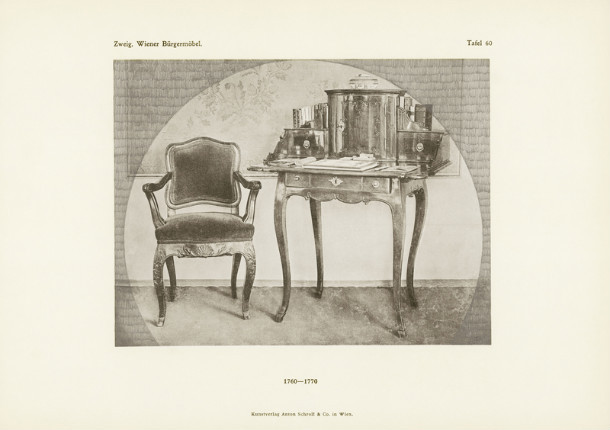Claudia Wieser
11 Dec 2010 - 12 Feb 2011
CLAUDIA WIESER
Portraits
11 Dec 2010 - 12 Feb 2011
“Each piece of furniture, each thing, each object tells a story, the story of the family. The apartment was never finished, it developed with us and we developed in it. No doubt there was no style in it. That is to say, there was no particular foreign or old style. However, the apartment still had style, the style of its inhabitants, the style of the family.” (Adolf Loos, Ins Leere gesprochen (Spoken Into The Void, translator’s note): 1897-1900, 1st reprint, Vienna: Prachner, 1987)
This text by Adolf Loos indicates the architect’s overall negative opinion on the “stylish” apartments of his time. In his view, these home furnishings meticulously planned by other architects lacked a “spiritual connection” with their inhabitants. Instead, Loos esteemed furniture full of spirit and magic.
Claudia Wieser’s inspiration for her solo exhibition Portraits at SCHAU ORT gallery stemmed from the picture pages of the book Wiener Bürgermöbel 1740-1790 (Furniture of Vienna’s Bourgeoisie, translator’s note), which was published in the 1920s. The black and white phototype images significantly stage the individual furniture pieces. Placed before an empty wall and set frontally to the viewer, an armchair and bureau look like a married couple posing for the camera. Claudia Wieser additionally amplifies these “personalities” with delicate interventions drawn onto the images. A dense structure of pencil strokes highlights the furniture pieces and lets them appear to be standing in the beam of a spotlight. By means of a simple alteration, Claudia Wieser changes the viewer’s impression of the image. This procedure is reminiscent of some earlier drawings, in which Claudia Wieser transformed landscapes depicted on vintage postcards into utopian scenarios with a few precise lines. The artist also uses the photographs of the furniture to create a room-filling installation: a collage of enlarged photocopies is pasted directly onto the wall. Reprocessed in this manner and integrated into the gallery space itself, the images convey a semblance of architectonic structures.
In her oeuvre, Claudia Wieser often combines references, form vocabulary, and techniques of art, architecture, and craftwork. The manipulated and reprocessed images of bourgeoisie furniture are juxtaposed with another series of drawings: using gold leaf or colored pencils on paper and employing reliefs of colored wood, Wieser searches for new possibilities to combine ornament and form. Elegant golden lines or diamond shapes on paper faintly resemble the ornamentations of the furniture pieces. Removed from their function to embellish something, these ornaments transform into concentrated compositions. Thus, Claudia Wieser often employs antique craft techniques for her own purposes; for instance when working with turned and painted wooden pillars or colored tiles.
Christiane Rekade
(Translated from German)
Portraits
11 Dec 2010 - 12 Feb 2011
“Each piece of furniture, each thing, each object tells a story, the story of the family. The apartment was never finished, it developed with us and we developed in it. No doubt there was no style in it. That is to say, there was no particular foreign or old style. However, the apartment still had style, the style of its inhabitants, the style of the family.” (Adolf Loos, Ins Leere gesprochen (Spoken Into The Void, translator’s note): 1897-1900, 1st reprint, Vienna: Prachner, 1987)
This text by Adolf Loos indicates the architect’s overall negative opinion on the “stylish” apartments of his time. In his view, these home furnishings meticulously planned by other architects lacked a “spiritual connection” with their inhabitants. Instead, Loos esteemed furniture full of spirit and magic.
Claudia Wieser’s inspiration for her solo exhibition Portraits at SCHAU ORT gallery stemmed from the picture pages of the book Wiener Bürgermöbel 1740-1790 (Furniture of Vienna’s Bourgeoisie, translator’s note), which was published in the 1920s. The black and white phototype images significantly stage the individual furniture pieces. Placed before an empty wall and set frontally to the viewer, an armchair and bureau look like a married couple posing for the camera. Claudia Wieser additionally amplifies these “personalities” with delicate interventions drawn onto the images. A dense structure of pencil strokes highlights the furniture pieces and lets them appear to be standing in the beam of a spotlight. By means of a simple alteration, Claudia Wieser changes the viewer’s impression of the image. This procedure is reminiscent of some earlier drawings, in which Claudia Wieser transformed landscapes depicted on vintage postcards into utopian scenarios with a few precise lines. The artist also uses the photographs of the furniture to create a room-filling installation: a collage of enlarged photocopies is pasted directly onto the wall. Reprocessed in this manner and integrated into the gallery space itself, the images convey a semblance of architectonic structures.
In her oeuvre, Claudia Wieser often combines references, form vocabulary, and techniques of art, architecture, and craftwork. The manipulated and reprocessed images of bourgeoisie furniture are juxtaposed with another series of drawings: using gold leaf or colored pencils on paper and employing reliefs of colored wood, Wieser searches for new possibilities to combine ornament and form. Elegant golden lines or diamond shapes on paper faintly resemble the ornamentations of the furniture pieces. Removed from their function to embellish something, these ornaments transform into concentrated compositions. Thus, Claudia Wieser often employs antique craft techniques for her own purposes; for instance when working with turned and painted wooden pillars or colored tiles.
Christiane Rekade
(Translated from German)

